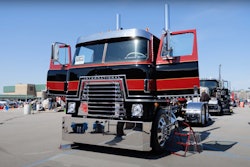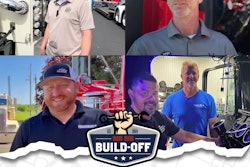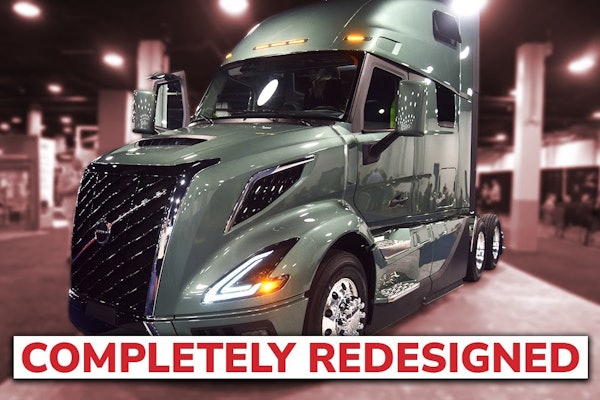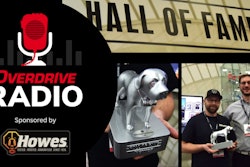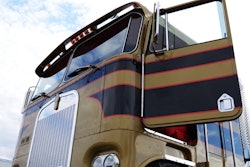There are Peterbilt fans, and there are Peterbilt fans, and Conrad Shada is the definition of one of the latter.
The independent owner-operator out of Anamosa, Iowa, got his start in trucking in May 2001. His father and grandfather ran two livestock auction markets and sold feeder cattle privately to local farmers. They had never had any trucks of their own, but Shada “caught the truck bug” at a young age and “always said from four to five years old I wanted to haul cattle for my dad and grandpa,” he said.
His grandfather knew this, but as the youngest of eight children who left school after the 8th grade, he told Conrad he had to get his education before he got into trucking.
After attending Iowa State University, Shada embarked on his long-envisioned trucking career.
“If it wasn’t for him telling me to do that, and he helped me get started, I don’t know if I would have made it through,” Shada said.
To this day, Shada remains in operation hauling cattle for his dad. He owns three trucks -- all Peterbilts, of course -- but just one Wilson livestock trailer. His operation, he said, is “atypical,” in that his dad tells him what he needs to do, and he goes and does it, but he sets his own schedule and manages his trucks and business.
“There’s nobody luckier,” he noted. “I’m very fortunate to have this situation.”
He typically hauls in a 2014 389 that he plans to do some custom work on in the near future. He also has a 1987 Peterbilt 362 cabover that’s heavily customized, and that he puts to work on occasion. His latest build, though, is the definition of a show-stopper.
“I’m attached to my trucks,” he said. “They’ve always been a staple in my life. Everybody’s got a hobby; I guess Peterbilts are mine.”
Unless you’re a hardcore truck enthusiast, just walking by Shada’s latest build few would blame you for thinking it was a 379. The reality, however, is that it’s a 2020 389 glider that Shada heavily modified and “completely rolled back the clock as close as we could” to the late-1980s-era 379 style.
“I was so attached to the '80s era of our business,” he said. “We had a lot of great truckers that were mentors to me as a little person. There was a lot of great people, and that era to me will always be special, and it was wonderful.”
 The truck was on display this past September at the 2023 Guilty By Association Truck Show, parked front-and-center outside the 4 State Trucks chrome shop.
The truck was on display this past September at the 2023 Guilty By Association Truck Show, parked front-and-center outside the 4 State Trucks chrome shop.
Shada said he always felt that the Model 379 Peterbilt “was the Cadillac” of the long-hood trucks. “I wanted to take a 389 and take bits and pieces of that 379 20-year run and put into it what I thought was the perfect truck. Is it the perfect truck? No. But to me it is.”
Like all of Shada’s trucks through the years, the 2020 389, nicknamed “Class of the Past,” is painted in Peterbilt’s Violet Effect color as the base with black and gold stripes. When he bought his first 379 in 2001, Violet Effect was only used on Peterbilt’s 387 model. He was able to talk the manufacturer into doing a 379 in the color, and he’s stuck with it ever since. He added the gold in later years because it was “a traditional old breaker stripe color.”
The full build took three and a half years. During that time, Shada and people he worked with touched and modified just about everything on the truck, as you can see and hear in the video up top. Among modifications were reskinning the doors, changing the door latches, fabricating the hood sides to look more like a 379, and installing 379 steps, door-mounted mirrors and more.
Shada said the biggest challenge of the whole build was in rewiring the dash. “It was enjoyable, but it took a lot of time,” he said. He also swapped in Multiplex gauges and toggle switches rather than the truck’s original rockers. The dash panels are painted, and the dash is leather-wrapped.
 As a whole, the interior is modeled after Peterbilt’s First Class style, which preceded the popular American Class interior. “It wasn’t around very long, but I just always liked the bigger squares.”
As a whole, the interior is modeled after Peterbilt’s First Class style, which preceded the popular American Class interior. “It wasn’t around very long, but I just always liked the bigger squares.”
Toward the back of the truck, he went with minimal lights -- opposite of what many cattle haulers prefer -- because it fits with the time period he intended to evoke, he said -- full fenders, too, chrome U-bolts to add accents, and more.
“I wanted to make it elegant and classy,” he said. “Everybody has their own taste, but I wanted to make that old-school as much as I could."
Shada’s attention to detail on the truck is what really stands out. Looking straight down at the truck from above, you would see that everything is uniform.
 Shada used a hood section to make the deck plate, and even inside the truck, the shifter plate is made out of a hood section.
Shada used a hood section to make the deck plate, and even inside the truck, the shifter plate is made out of a hood section.
And: “Anything you see on the outside is done on the inside or bottom side,” he added. If someone were to crawl up under the deck plate, or look at the underside of the hood, they're painted to match the striping of the outside of those sections of the truck.
The truck boasts a 1999-model 3406E 2WS Cat. “In the 80s era, if you had a Pete, a Cat, and a Wilson trailer, you were in the upper echelon,” he said. “That’s what we tried to mold this after.”
 Shada painted the engine white, typical of Peterbilt engines in the 1980s, he said. He "thought it would look nice with the chrome and braided lines."
Shada painted the engine white, typical of Peterbilt engines in the 1980s, he said. He "thought it would look nice with the chrome and braided lines."
The biggest giveaways that the truck is indeed a 389 are the width of the hood at the top and the length of the hood, along with the angled hood seam. The 379 seam, where the two panels meet, was straight rather than angled.
With all the time and effort put into the rig, Shada said it will likely never be a full-time worker, though at the time of GBATS in September he's put about 7,000 miles on it hauling some cattle, among other travels. “It will be used in the summer months a little bit here and there, but I’ll try and keep it off the gravel roads,” he said.
Catch plenty more views of the truck in the video up top. For more videos and custom-equipment features delivered to your email inbox, subscribe to Overdrive's weekly Custom Rigs newsletter via this link.
Conrad Shada: When we started taking the truck to shows, people would walk by and say, "Well, that's a nice 379." And then once they started looking at it, they started finding things and it's like, "Well, I don't remember this," or, "I don't remember that from that era." And they asked, "What year is this truck?" And you'd say, "Well, it's a 2020 389."
My name is Conrad Shada, and I own Conrad Shada Trucking Incorporated out of Anamosa, Iowa. It's a 2020 389 Peterbilt Glider, one of the last Gliders built, and I was so attached to the '80s era of our business, I always thought 379 was the Cadillac. But I wanted to take a 389 and take bits and pieces of that 379 20-year run, and put into it what I thought was the perfect truck. Now, is it the perfect truck? No, but to me it is, so I, like I said, just took those bits and pieces out of those 20 years.
This is a '99 Caterpillar, 3406E 2WS. In the '80s era, if you had a Peterbilt, a Caterpillar, and a Wilson trailer, you were the upper echelon, so that's what we tried to mold after. And I've always been a Caterpillar fanatic. I painted the engine white, just because white was an old Peterbilt color back in the '80s, and I thought it would look really nice with the chrome and the braided lines. The only thing is, white is really fun to keep clean.
We changed the hood sides, had the hood sides fabricated. Striped the inside of the hood, put emblems on the inside of the hood. Everything that's on the outside is on the inside. Put up 379 headlights, fenders, steps, had a custom grill sheet made, and that is a stainless steel 389 grill crown. I changed the toolboxes out to the old, early 379 steps and fabricated those. The doors, re-skinned doors, door mounted mirrors. On the inside, put a new old stock 379 dash in it, rewired the dash, but used the multiplex gauges and switched the rockers over to toggles for that old school look. The interior is not modeled after American class, but after first class. That was the pre-American class back in about '89, '90.
It wasn't around very long, but I just always liked the bigger squares, and like I said, we were going for that 1987 look. So that's why we did that. Did a lot of the custom stuff inside, painted the dash panels, had a superior upholsterer that wrapped all the dash in leather. On the shifter plate, we even put a piece of hood section on that. And my wife and her mother made a blanket in the back that has that center section on it, too.
Then moving on to the back, it seems like livestock haulers always have to have a lot of lights, but I kind of went back in time to minimize the lights because that was kind of the era. Just two load lights, put the air tanks underneath my toolbox because that was a 359 option, more, but there were options for that on a 379. Full fenders, because that was the old school look. For some of the detail stuff, we cut a hood section and stripped the bottom side off, so the hood section runs on the top of the deck plate. So if you were looking down at the truck, everything matches and anything that you see on the outside is done on the inside or the bottom side. If you would even crawl under there, the bottom of the deck plate is striped.
These are Alcoa wheels, and had them milled out to the specific dimension of what that era was, because the round holes now are just a little bit larger. So the chromed axle nut covers polished all the brass fittings, would bring the stripes through the doors and the door jams. The old double bubble lights with the chrome guards.
We painted each piece individually, cab sleeper and hood.
I've always had the Violet Effect color as the base color. The Violet Effect color was exclusive to the 387 at the time when they come out with that back in 2001. So we talked Peterbilt into painting a 379 that color, and stayed with black and added the gold over the later years because the gold was such a traditional old breaker stripe color.
It took three and a half years. I can't do paint, I don't like paint, but I love the fabrication in the assembly. I did probably 98% of the building of the truck myself, but none of the paint work. People say, "Well, it's your name on the door." Yeah, but if it wasn't for some of the people that helped me, it couldn't have been done.



